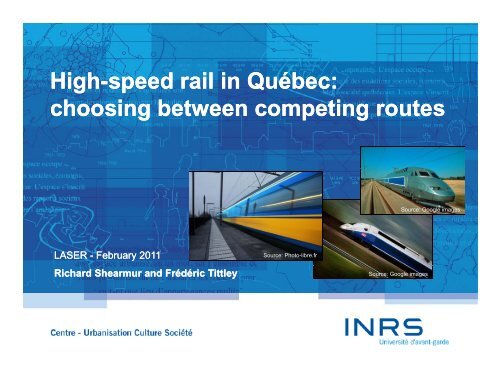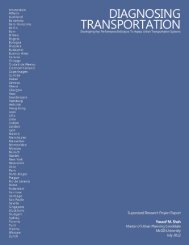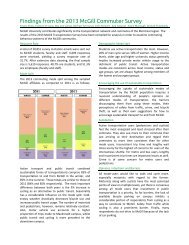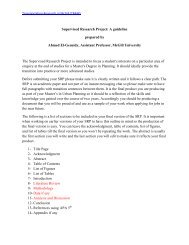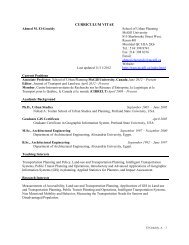Presentation - Transportation Research At McGill (TRAM)
Presentation - Transportation Research At McGill (TRAM)
Presentation - Transportation Research At McGill (TRAM)
Create successful ePaper yourself
Turn your PDF publications into a flip-book with our unique Google optimized e-Paper software.
High-speed rail in Québec:choosing between competing routesSource: Google imagesLASER - February 2011Richard Shearmur and Frédéric TittleySource: Photo-libre.frSource: Google images
IntroductionHigh speed rail in the Quebec-Windsor corridor- an idea that comes and goes with regularity(e.g. Bombardier proposal, 1991; 2008 proposal (La Presse, 2011))High speed rail in the USA- an idea that came in 2008 (and has maybe gone already...)
http://brokensidewalk.com/wp-content/uploads/2009/02/high_speed_rail_map_03.jpgRailtechnology.com, 2011
In Canada....• A few disparate feasibility studies, and recent federalprovincial agreement to update them (2007)– what type of technology?– should we use existing or new railways?– will it interfere with goods hauling– will it make money (who will use it?)But no real interest in wider regional implications.It is assumed that the link will be beneficial, and it isusually justified on ecological and/or congestiongrounds
How did I get into this?• In Autumn 2009 I was contacted by ‘Objectif Rive-Sud’.• A lobby group of mayors and Chambers ofCommerce who want a south shore route to beconsidered.• According to them, there is an implicit concensus inQuebec that a TGV will run from Québec to Montrealalong the North shore.
Two possible routes through QuébecOn what basis should a choice be made ?
• The natural response of transport engineersis to consider the following question:– what is the cheapest and technically mosteffective way of linking Quebec to Montreal at highspeed?• But such a question assumes that the rail linkhas no effect on intervening regions.
Two possible routes through QuébecOn what basis should a choice be made ?
• If the train stops (and there is no reason to think thata high-speed train cannot stop – acceleration is veryfast), then the question changes.• To the engineering question – which remainsimportant – must be added a more complex (becausethere are few criteria) one:– what are the impacts of the high-speed rail link on theregions through which it runs?– is there any reason to think that one route will be far morebeneficial than another route?
What is an impact?• There are at least as many ways of evaluating impactas there are academic sub-disciplines.• The reason why I became involved is that, with mycolleagues, I have studied the economic (i.e.employment) impact of infrastructure
What is an impact?• Why does transport infrastructure have an economicimpact?• It enables and facilitates the transport of goods andpeople (i.e. tacit knowledge, ideas, social ties).• In a more abstract sense the key economic role ofIn a more abstract sense, the key economic role ofinfrastructure is to provide accessibility
Two identical infrastructures: which will have most economic impact?- same number of construction jobs- but once built one has an economic function and the other doesn’t
Is there any empirical basis for this argument?Surprisingly few studies have looked at the wider economicimpacts of new infrastructure (i.e. at the connection betweenaccessibility and economic development).Mario Polèse, Philippe Apparicio, Gaétan Dussault and myself did, pp pp , yso, for Canada, in 2007.(http://projetic.ucs.inrs.ca/pdf/report_IC.pdf )
Is there any empirical basis for this argument?Methodology:Shearmur & Polèse (2007) – an employment growth model forCanada which takes into account- local factors (human capital, industrial structure, localcosts, lcoal diversity)- structural factors (centre/periphery, urban/rural, region,city size)Does an accessibility variable (along transport networks) addDoes an accessibility variable (along transport networks) addanything to this model?
Accessibility along transportnetworks contributes to employmentgrowth over and above othergrowth factors commonlyrecognised in the developmentliterature.
In particular accessibilityby road and air hasa major impact
So, the natural question, in the context ofQuebec’s TGV:• How will increasing the accessibility of certain regionsaffect their employment growth?• how will employment gains be distributed across space?• is there any clear advantage (in terms of absolute number ofjobs ‘created’) to taking the North shore or the South shoreoption?
Air networkMéthodology
The growth model usedDependent variable• Employment growth 2001-20062006Independent variables (Shearmur & Polèse 2007)• P = Provinces• UC = Urbain / rural, central / peripheral• S = Log population• E = % graduates• W = mean wage (indicator of costs)• I = dummies for industrial profiles Contribution %Accessibility variables• Existing air/road accessibility along current networks• Projected air/road accessibility after adding TGV (North and South)
Impact of TGV• In terms of growth RATE (%)R1 = (Accessibility with TGV – Accessibility without) * regressioncoefficient• In absolute terms (number)R2 = R1 * total employment in 2001
Note:• Both accessibility variables (with TGV and without) are standardised• Thus ‘Accessibility with TGV – Accessibility without’ can be positive ornegative, and system-wide gains in accessibility (i.e. the sum of thisdifference) will be zero – a zero sum game.• This means that the impact of accessibility on growth rates will tend tozero (i.e. on average there will be as many positive as negative impactson growth rates)• BUT: this does not mean that t there will be no overall employment gains.• there will be net gains if the positive impacts are in high employment regions.• there will be net losses if the pnegative impacts are in high employmentregions.
Results
Overview of results: geography of changes ingrowth rates – NORTH route
Overview of results: geography of changes ingrowth rates – SOUTH route
Overview of results: geography ofnew jobs created, NORTH routeNew jobs:24 513Mean: 61Max: 5471Median: 0Min: -73
Overview of results: geographyof new jobs created, SOUTH routeNew jobs:22 559Mean: 56Max: 5479Median: 0Min: -62
Beware• This is a theoretical exercise– in particular it ignores jobs created during the construction process.– dynamic (cumulative) effects that may amplify these static effects.– cost factors• who will use the TGV?• will it actually be used it cars and buses remain a lot cheaper?– the total number of jobs created (or not) depends on the treatmentof the accessibility variable (in our case no net accessibility gain)– however, this does not alter the geographic insights, orcomparisons between alternative options.
Conclusion• The TGV has a concentrated local effect whichdoes not spread far beyond the places where it stops.• Although small cities where it stops benefit from aboost to their growth RATES, only largemetropolitan areas benefit from significantemployment creation (500 jobs or more).• The effect of the TGV depends partly on where youareWindsor and Quebec City benefit less (lower impact on– Windsor and Quebec City benefit less (lower impact ongrowth rates) than cities along the line.
ConclusionChoice between North Shore and South shore?– very little difference in terms of jobs creation– although h the South Shore is more economically dynamic andhas more jobs in it, these are dispersed.– Since the TGV effects are geographically focussed, manyjobs are created in the large city of Trois-Rivières.ièHOWEVER: the crux of the choice may lie elsewhere.How will the high-speed rail link enter Montreal: from theNorth or from the South?
http://brokensidewalk.com/wp-content/uploads/2009/02/high_speed_rail_map_03.jpgRailtechnology.com, 2011
ConclusionIf Montreal (and the province of Quebec) wishes to one day benefitfrom high-speed access to New England, Boston and New York,clearly a southern entrance is to be preferred.Since there is very little difference in impact between the twoshores, these wider accessibility (but also urban planning, bridgebuilding, and station ti design) implications should carry greatweight.However, high-speed rail is still a pipe-dream in North America...


